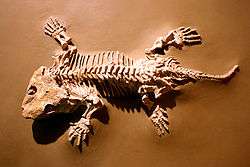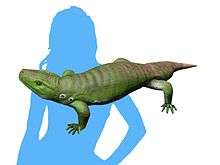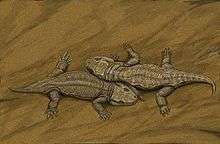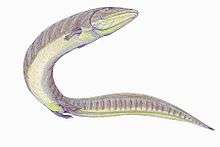Seymouria
| Seymouria | |
|---|---|
 | |
| Seymouria baylorensis from the Early Permian of North America, Museum of Natural History, Washington | |
| Scientific classification | |
| Kingdom: | Animalia |
| Phylum: | Chordata |
| Order: | †Seymouriamorpha |
| Family: | †Seymouriidae |
| Genus: | †Seymouria Broili, 1904 |
| Species | |
| |
| Synonyms | |
| |
Seymouria was a reptile-like tetrapod from the early Permian of North America and Europe (approximately 280 to 270 million years ago).[1] It was small, only 2 ft (60 cm) long. Seymouria was well adapted to life on land, with many reptilian features—so many, in fact, that it was first thought to be a primitive reptile.
Description

The dry climate of the Permian suited creatures like reptiles better than amphibians and other thin-skinned tetrapods, but Seymouria had many reptilian features that helped it in this harsh environment. It had long and muscular legs, and may have had dry skin and the ability to conserve water. It may have been able to excrete excess salt from its blood through a gland in its nose, like modern reptiles. All of this meant that Seymouria, unlike amphibians and other early tetrapods, might have lived for extended periods of time away from water. If so, this would have allowed it to move about the landscape in search of insects, small amphibians, and other possible prey, such as the eggs of reptiles and synapsids.
Male Seymouria had thick skulls that may have been used to batter rivals in mating contests. After mating, the females would have had to return to water to lay their eggs. As in amphibians, the larvae would develop in water, hunting for worms and insects until they were strong enough to live on land. While no larvae are known from Seymouria itself, fossil larvae of its relative Discosauriscus and other species in the order Seymouriamorpha have been found, with impressions of external gill structures as in modern amphibians.
History of discovery


Fossils of Seymouria were first found in Seymour, Baylor County, Texas (hence the name of the type species, Seymouria baylorensis, or "Baylor County of Seymour"). Over the years, many well preserved fossils have been found in North America and Germany, including the "Tambach Lovers", two individuals of S. sanjuanensis fossilized lying next to each other (though of course it cannot be determined whether they really were a couple killed during mating). Seymouria agilis (Olson, 1980) that is known from only one specimen (holotype UCMP 143 277), a nearly complete skeleton from the Chickasha Formation of Oklahoma, was reassigned by Michel Laurin and Robert R. Reisz to Macroleter.[2]
See also
![]()
References
- ↑ Laurin, Michel (January 1, 1996). "Seymouria". Tree of Life Web Project. Paris: Muséum National d'Histoire Naturelle. Retrieved February 24, 2018.
- ↑ Laurin, Michel; Reisz, Robert R. (September 2001). "The reptile Macroleter: First vertebrate evidence for correlation of Upper Permian continental strata of North America and Russia" (PDF). Geological Society of America Bulletin. University of Toronto. 113 (9): 1229–1233. doi:10.1130/0016-7606(2001)113<1229:trmfve>2.0.co;2. Archived from the original (PDF) on March 11, 2012.
Bibliography
- Laurin, M. (1996) A Redescription of the Cranial Anatomy of Seymouria baylorensis, the best known Seymouriamorph (Vertebrata: Seymouriamorpha) PaleoBios, 17(1):1-16
External links
![]()






